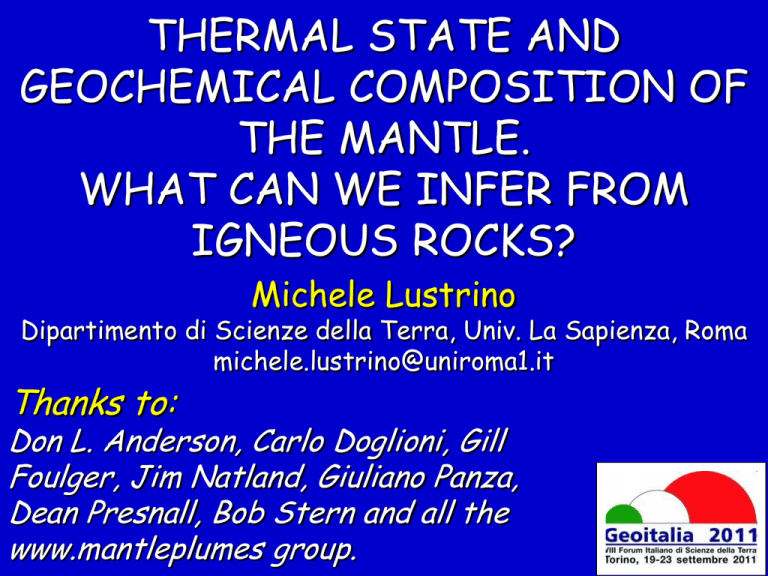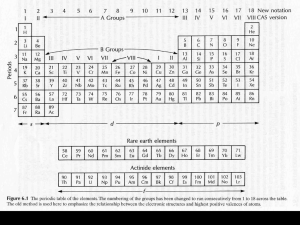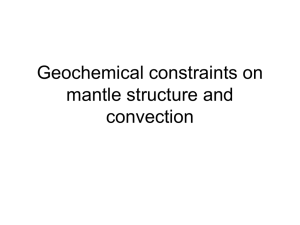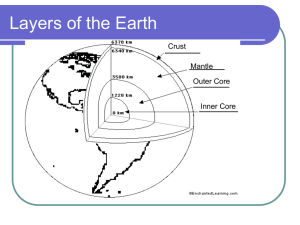Lustrino2011 - Do plumes exist?
advertisement

THERMAL STATE AND GEOCHEMICAL COMPOSITION OF THE MANTLE. WHAT CAN WE INFER FROM IGNEOUS ROCKS? Michele Lustrino Dipartimento di Scienze della Terra, Univ. La Sapienza, Roma michele.lustrino@uniroma1.it Thanks to: Don L. Anderson, Carlo Doglioni, Gill Foulger, Jim Natland, Giuliano Panza, Dean Presnall, Bob Stern and all the www.mantleplumes group. Attention Plumers: This is an Anti-Plume Talk! Chemical Geodynamics (Zindler and Hart, 1986) has proposed a strict link between geochemistry and geophysics. Geochemical models/hypotheses have been commonly, AND DANGEROUSLY, translated into physical concepts. A mental loop or circular reasoning is created when geochemical concepts are used to reinforce geophysical evidence (and vice-versa). No clear and unequivocal thermal and chemical models for the upper/whole mantle are yet available. Important and fundamental concepts are not yet fully understood and accepted worldwide with the same significance: Upper Mantle? Transition Zone Mantle? Lithosphere? Asthenosphere? Boundary Layers? Depleted/Enriched/Primitive/Fertile Mantle? Unsupported assumptions: 1 Upper mantle is: - Homogeneous - Chemically depleted This is a BASIC ASSUMPTION (Green and Ringwood, 1967; De Paolo and Wasserburg, 1976). Plumers adopted this approach to propose deeper sources for OIB-like magmas. The mantle sources of several OIB types are not much different from MORB source from a Sr-Nd-Pb isotopic point of view. MORBs From: White, 2010 (Ann. Rev. Earth Planet. Sci.) MORBs The mantle sources of several OIB types are not much different from MORB source from a Sr-Nd-Pb isotopic point of view. Depleted Isotopic Field 1) MORB sources are isotopically depleted. 2) The depletion is ancient (evolution with low Rb/Sr and low Nd/Sm for several Ga). From: Hofmann, 2004 (Encyclopedia of Geochemistry) The mantle sources of several OIB types are not much different from MORB source from a Sr-Nd-Pb isotopic point of view. Depleted Isotopic Field From: Hofmann, 2004 (Encyclopedia of Geochemistry) OIB Vague definition OK Vague definition based on assumptions Again vague definition Definition based on assumptions, not evidence Unrelated to subduction? From: Hofmann, 1997 (Nature, 385, 219-229) Are Hawaiian magmas geochemically unrelated to subduction? Sobolev et al (2011) A young source for the HawaiianPlume. Nature Huang et al (2011) Stable calcium isotopic compositions of Hawaiian lavas: Evidence for recycling of ancient marine carbonates into the mantle. Geochim. Cosmochim. Acta Fodor and Bauer (2010) Kahoolawe Island, Hawaii: The role of an ‘inaccessible’ shieldv olcano in the petrologyof the Hawaiian islands and plume. Chem Erdie Ren et al (2009) Geochemical differences of the Hawaiian shield lavas: implications for melting process in the heterogeneous Hawaiian plume. J. Petrol. Huang et al (2009) Ancient carbonate sedimentary signature in the Hawaiian plume: evidence from Mahukona volcano, Hawaii. Geochem. Geophys. Geosyst. Blichert-Toft and Albarede (2009) Mixing of isotopic heterogeneities in the Mauna Kea plume conduit. Earth Planet. Sci. Lett. Sobolev et al. (2007) The amount of recycled crust in sources of mantle-derived melts. Science. Nielsen et al. (2006) Thallium isotopic evidence for ferromanganese sediments in the mantle source of Hawaiian basalts. Nature Herzberg (2006) Petrology and thermal structure of the Hawaiian plume from Mauna Kea volcano. Nature Huang e Frey (2005) Recycled oceanic crust in the Hawaiian plume: evidence from temporal geochemical variations within the Koolau Shield. Contrib. Mineral. Petrol. Gaffney et al. (2005) Melting in the Hawaiian Plume at 1-2 Ma as recorded at Maui Nui: the role of eclogite, peridotite and source mixing. Geochem. Geophys. Geosyst. Sobolev et al. (2005) An olivine-free mantle source for Hawaiian shield lavas. Nature. Unsupported assumptions: 1 Upper mantle is: - Homogeneous - Chemically depleted This is a BASIC ASSUMPTION (Green and Ringwood, 1967; De Paolo and Wasserburg, 1976). The concept itself of “Normal-MORB” is an invention. …Normal with respect to what? Unsupported assumptions: 1 Upper mantle is: - Homogeneous - Chemically depleted Was Igor Normal? …Probably yes, but only in the Frankenstein Castle… Unsupported assumptions: 1 Upper mantle is: - Homogeneous - Chemically depleted ….D-MORB, N-MORB, T-MORB, E-MORB, P-MORB Anomalies along the ridge system–elevation, chemistry, physical properties are part of a continuum and the distinction between ‘normal’ and ‘anomalous’ ridge segments is arbitrary and model-dependent. (NewTOE; Anderson, 2007) Unsupported assumptions: 1 Upper mantle is: - Homogeneous - Chemically depleted Selected trace element variability of a SMALL set of MORBs (40-55° S. Atlantic Ocean) From: Hofmann, 2004 (Encyclopedia of Geochemistry) Unsupported assumptions: 1 Upper mantle is: - Homogeneous - Chemically depleted …Mmmhhh… Heterogeneous MORB sources? “Heterogeneities from plumes may comprise a substantial fraction of all heterogeneities in the MORB source.” (Davies, 2009, G3) Unsupported assumptions: 1 Upper mantle is: - Homogeneous - Chemically depleted Pay attention in distinguishing “Fertile” from “Enriched”. MORB sources are not enriched (low incompatible trace element content) but are not necessarily sterile or refractory (they are essentially four-phase lherzolite, producing lithophile-element-rich melts). Unsupported assumptions: 1 Upper mantle is: - Homogeneous - Chemically depleted Pay attention in distinguishing “Fertile” from “Enriched”. Fertile vs. Sterile (capacity or lack there of to generate basaltic melts) Enriched vs. Depleted (incompatible trace element content). Unsupported assumptions: 1 Upper mantle is: - Homogeneous - Chemically depleted Basalts (and therefore MORBs too) are generated when all four of the lherzolite phases are present in some proportion. The relative amounts of these minerals is not important, so that some of these basaltyielding source regions would be called pyroxenites, harzburgites or lherzolites. Unsupported assumptions: 1 Upper mantle is: - Homogeneous - Chemically depleted Mantle rocks can be, at the same time: Fertile and Enriched (e.g., OIB sources) Fertile and Depleted (e.g., MORB sources) Sterile and Enriched (e.g. Harzburgite xenoliths) Sterile and Depleted (unable to produce basalts) Unsupported assumptions: 2 Asthenosphere is: - Fully convecting -Chemically homogeneous and depleted The Asthenosphere is a layer that is able to flow or creep. It is not elastic and not rigid. It deforms under a load because it has relatively low viscosity. This deformation can be simple laminar flow, as when a plate moves over a viscous fluid. This does not mean that it is homogeneous or fully convecting. Unsupported assumptions: 2 Asthenosphere is: - Fully convecting -Chemically homogeneous and depleted The axiom: Asthenosphere = Convecting mantle = Vigorously stirred mantle = Homogeneous mantle is simply not correct. This is based on the assumption that MORBs = Homogeneous magmas = Homogeneous mantle sources = Convecting = Well mixed source. Unsupported assumptions: […] “The presence in oceanic basalts of a common mantle component that is not the ubiquitous depleted upper mantle (asthenosphere) of mid-ocean ridge basalts (MORB) is probably one of the major findings of igneous isotope geochemistry” (Cadoux et al., 2007 EPSL). […] “Geophysical evidence and numerical models of mantle stirring imply the source of mid-ocean ridge basalts (MORBs) comprises most of the mantle, excepting only the D” region and the ‘‘superpile’’ anomalies deep under Africa and the Pacific.” (Davies, 2009 G3). [...] “We modeltwo mantle reservoirs corresponding in mass to the Earth’s upper mantle (MORB source) and lower mantle (OIB source), respectively.” (Gonnermann and Mukhopadhyay, 2010, Nature) Unsupported assumptions: 2 Asthenosphere is: - Fully convecting -Chemically homogeneous and depleted The asthenosphere is a relatively lowviscosity layer, not a vigorously stirred and convecting layer. Plate tectonics and post-glacial rebound (isostasy) require a low viscosity, not vigorous convection. Unsupported assumptions: From: Anderson, 2011 (J. Petrol.) Upper Boundary Layer B Region of Gutenberg (1959) Laterally Advecting Melt and Anisotropic Fraction Mantle 50-120 km Classically defined “Asthenosphere” “Fixed (convecting)” Mantle Unsupported assumptions: From: Anderson, 2011 (J. Petrol.) 50-120 km G Discontinuity Melt In (or fluid-rich) Classically defined “Asthenosphere” L Discontinuity Melt Out (or fluid-poor) Melt Fraction “Fixed (convecting)” Homogeneous (convecting) “Asthenosphere” Mantle Unsupported assumptions: Seismic Lid LITHOSPHERE By definition (McKenzie and Bickle, 1988) the LITHOSPHERE is the non-convecting part of the mantle characterized by conductive geotherm From: Anderson, 2011 (J. Petrol.) 50-120 km Classically defined “Asthenosphere” “Fixed (convecting)” Homogeneous (convecting) “Asthenosphere” Mantle Unsupported assumptions: 3 Tomography can be used to measure the temperature of the mantle Positive Vs and Vp anomalies can be related to the presence of less dense material (e.g., depleted harzburgite, seismic lid) and low velocity anomalies can be dense eclogite. Tomographic images are perturbations of an initial reference model, and the assumed model may greatly influence the final results. Unsupported assumptions: From: Kumagai et al., 2008 (GRL) a = Grand et al. 2007 b = Mègnin and Romanowicz, 2000 c = Ritsema et al., 1999 d = Montelli et al., 2006 Plume or not under Iceland? a b c d Unsupported assumptions: 50 km 100 km Pacific Plate Tomography Where is the Hawaiian thermal plume? Maggi et al., 2006 (EPSL) 150 km 200 km 250 km 300 km Unsupported assumptions: Where is the Hawaiian thermal plume? Kustwosky et al., 2008 (J Geophys Res) Pacific Plate Tomography Unsupported assumptions: Mantle Plume trace? This too? Schmerr et al. 2010 (EPSL) Unsupported assumptions: 3 Tomography can be used to measure the temperature of the mantle “Red" patches in tomographic images can be fine grained peridotite, eclogite, H2O, CO2 or melt. With volatiles or eclogite components it is not necessary to dream up mechanisms to cause melting or raise the temperature. Unsupported assumptions: 3 Tomography can be used to measure the temperature of the mantle Seismic wave velocity is also dependent on the direction in which the waves travel. The velocities of surface waves (large horizontal component of motion) are different from steeply up-coming S waves (large vertical component). Unsupported assumptions: 3 Tomography can be used to measure the temperature of the mantle “Improved seismology is likely to become definitive on the question of existence of plumes in the mid-mantle. We really do not know how the deep Earth works. We need much more seismic data.” (Sleep, 2006, Earth Sci. Rev.) Unsupported assumptions: 3 Tomography can be used to measure the temperature of the mantle Seismology has simply no more power to map hot plumes than geochemistry (and geochemistry can say NOTHING about T) Unsupported assumptions: 3 Tomography can be used to measure the temperature of the mantle “Between the depths of 100 and 250 km, the velocity anomalies detected below the present study region are approximately 2–2.5% slower than average, implying a temperature excess of about 220–280 K, which is consistent with estimates for other mantle plumes.” (Macera et al., 2003 J. Geodyn.) “[…] we compute instantaneous, three-dimensional spherical-mantle flow driven by temperature (density) anomalies as inferred from seismic tomography, assuming that velocity anomalies are simply related to temperature.” (Faccenna and Becker, 2010, Nature) Unsupported assumptions: 4 The Potential Temperature (Tp) of the mantle at the base of the Plate (~100 km) and for the whole upper mantle is ~1280°C. The potential temperature is the temperature the mass would have (hence the term “potential”) if it were compressed or expanded to some constant reference pressure (1 atm). This concept is based on the assumption of a homogeneous and isothermal upper mantle at a given depth. Unsupported assumptions: 4 The Potential Temperature (Tp) of the mantle at the base of the Plate (~100 km) and for the whole upper mantle is ~1280°C. The concept itself of Tp should be considered in relation to the depth of magma formation. Magmas formed at high P show high Tp; magmas formed at shallower P show lower Tp. This does not imply any kind of thermal anomaly, but it indicates a temperature gradient in the mantle. Potential Temperature Two main models concerning Mantle Potential Temperature: The difference between the two models described above depends on the assumptions: Assuming a “normal” mantle potential temperature of~1280 °C, magmas formed at higher temperatures (e.g., in mid-plate area ssuchas Hawaii) comes from hotter sources. “…Geochemistry provides convincing evidence that mantle plumes are 100–300 °C hotter than normal upper mantle” W. M. White, 2010 (Oceanic Island Basalts and Mantle Plumes: The Geochemical Perspective. Ann. Rev. Earth Planet. Sci. 38, 133-160) Potential Temperature Two main models concerning Mantle Potential Temperature: The difference between the two models described above depends on the assumptions: Assuming a “normal” mantle potential temperature of~1280 °C, magmas formed at higher temperatures (e.g., in mid-plate areas suchas Hawaii) comes from hotter sources. Alternatively: The MORB source is colder than elsewhere (because extensive melting cools the upper mantle). In this case, the anomaly is not the mid-plate mantle, but the MORB sources. Potential Temperature Two main models concerning Mantle Potential Temperature: The difference between the two models described above depends on the assumptions: “Long wavelength temperature variation sof the asthenosphere (LAM) depart from the mean by ±200 °C, not the ±20 °C adopted by plume theoricians. The ‘normal’ variation, caused by plate tectonic processes (subduction cooling, continental insulation, small scale convection) encompasses the temperature excesses that have been attributed to hot jets and thermal plumes.” (Anderson, 2000, Geophys. Res. Lett.). Potential Temperature 900 0 4 6 8 1110 E 1300 1220 1350 1500 1480 1550 D C B (one of the possible) Geotherm A What is the Mantle Potential Temperature at these points? 1700 100l Depth (km) Pressure (GPa) 2 1100 Conductive Layer An upwelling mantle volume may start melting at A, B, C, D, E, … …, when it crosses the local solidus. Temperature (°C) or Thermal Boundary Layer A magma forms where the mantle temperature crosses the Solidus. 200 Unsupported assumptions: 4 The Potential Temperature (Tp) of the mantle at the base of the Plate (~100 km) and for the whole upper mantleis~1280°C. Hawaii may have ambient Tp up to 1600 °C, but so does most of the mantle away from ridges. The Pacific asthenosphere away from hotspots is as hot as Hawaii asthenosphere (e.g., heatflow). Unsupported assumptions: 5 Geochemistry clearly indicates provenance of OIB from deep mantle. Much is based on the original model of crustal recycling by A.W. Hofmann. Very radiogenic 206Pb/204Pb isotopic ratios (>21) of an extremely rare group of OIBs (~12%) (HIMU-like) is compatible with the recycling of high 238U/204Pb altered oceanic crust and very long storage and isotopic growth of 206Pb from the parent 238U (>2 Ga). Unsupported assumptions: 5 Geochemistry clearly indicates provenance of OIB from deep mantle. Storage in the deepest lower mantle was considered necessary to allow the isotopic growth in the recycled slab to be not involved in the supposedly vigorous stirring of the rest of the mantle. Recently this long isolation (>2 Ga) has been considered not necessary. Sr isotopes on Hawaiian melt inclusions require younger recycling ages (0.2-0.6 Ga)(Sobolev et al., 2011, Nature) 1st possibility: Recycling and folding at 670 km 2nd possibility: Recycling and folding at D” (2900 km) ? X Only after substantial isotopic growth would the 206Pb/204Pb have reached very radiogenic values (up to 21-22) Storage of high (High U/Pb) recycled oceanic crust for >2 Ga, allowing isotopic growth of 206Pb 238U/204Pb From: Stern (2002) Rev. Geophys., 40, doi:10.1029/2001RG000108 Unsupported assumptions: 6 Magmas in equilibrium with mantle sources (primitive melts) must have Mg# [Mg/(Mg+Fe)] ~0.7 This concept is based on the assumption of a distribution coefficient of Fe and Mg between an Mg-rich solid source (Mg# ~90) and a partial melt. Upper mantle is characterized also by the presence of Mg#-poorer lithologies (e.g., eclogites or pyroxenites s.l.). Unsupported assumptions: 6 Magmas in equilibrium with mantle sources (primitive melts) must have Mg# [Mg/(Mg+Fe)] ~0.7 This may have strong effects when recalculating the “original” melt composition of basaltic rocks assuming melts with MgO up to 15 wt% in equilibrium with mantle residua. This would mean that some (or all) the olivinemelt thermometric estimates are overestimated. Unsupported assumptions: 7 High magma production is related to High Absolute Temperature. This definition is not correct, because high melt productivity can be related to High Homologous Temperature. The Homologous Temperature is the ratio of the temperature of a substance to the melting temperature (solidus for natural systems) of the same substance. Unsupported assumptions: 7 High magma production is related with High Absolute Temperature. This definition is not correct, because high melt productivity can be related to High Homologous Temperature. In a lherzolitic mantle at a given depth, the H.T. may be: 1000°C/1300°C = 0.76. At the same depth, in an eclogite-bearing mantle the H.T. may be: 1000°C/1000°C. = 1.00. An eclogite-bearing mantle has higher H.T. Unsupported assumptions: 7 High magma production is related to High Absolute Temperature. This definition is not correct, because high melt productivity can be related to High Homologous Temperature. Huge amounts of melts can, thus, be produced at “normal/average” mantle temperatures from low temperature-melting mantle assemblages (e.g., eclogite-bearing peridotites). Unsupported assumptions: 7 High magma production is related to High Absolute Temperature. Many geochemists assert that the whole upper mantle is MORB, cold and homogeneous and that MORB comes from ambient convecting mantle. There is plenty of room and magma in the 220 kmthick Boundary Layer to provide Hawaii, Ethiopia, Siberia, Deccan, Kerguelen and Ontong Java LIPs. Unsupported assumptions: 8 Intra-plate magmatism is relatedto the presence of mantle plumes. True INTRA-PLATE magmatism does not exist. Igneous activity always develops at plate margins (i.e., along lithospheric discontinuities). Edge-driven effects, lithosphere cracking, small-scale convection beneath the seismic lid and/or shear heating at the base of the lithosphere can contribute to magma formation. Unsupported assumptions: 8 Intra-plate magmatism is relatedto the presence of mantle plumes. Unsupported assumptions: 8 Intra-plate magmatism is relatedto the presence of mantle plumes. From: Babuska et al. (2002) Tectonics, 21, 10.1029/2001TC901035 Unsupported assumptions: 8 Intra-plate magmatism is relatedto the presence of mantle plumes. Igneous activity in a cratonic area? An oxymoron. This model works also without a plume. It is a sort of edgedriven effect Why invoke the presence of a PLUME? From: Sleep (2006) Earth Sci. Rev. PLUME Unsupported assumptions: 8 Intra-plate magmatism is relatedto the presence of mantle plumes. […] “for certain geometries and viscosity ratios, circulatory flow develops within a “cavity” or “step” embedded into the lithospheric base, or within a lowviscosity “pocket” embedded within the asthenospheric layer.” Calculated Shear-Driven Upwelling rates for asthenosphere shearing at 5 cm/yr: 0.2 cm/yr (continental rift), 0.5 cm/yr (craton edge), 1.0 cm/yr (within a “pocket” of low-viscosity asthenospherere) (Conrad et al., 2009, Phys. Earth Planet. Int.) Unsupported assumptions: 8 Intra-plate magmatism is relatedto the presence of mantle plumes. “Such asthenosphere viscosity heterogeneity may be associated with thermal, chemical, melting, volatile, or grain-size anomalies, and is consistent with tomographic constraints on asthenospheric variability. We estimate that shear-driven upwelling may generate up to 2.5 km/Myr of melt that is potentially eruptible as surface volcanism” (Conrad et al., 2009, Phys. Earth Planet. Int.) Unsupported assumptions: 8 Intra-plate magmatism is relatedto the presence of mantle plumes. Ac = Wc/Hc (width of the cavity) Tc = Hasth/(Hasth+Hc) (asthenosphere thickness with and without the cavity) Unsupported assumptions: 8 Intra-plate magmatism is relatedto the presence of mantle plumes. Flow velocity in the cavity as a fraction of the assumed original velocity of the asthenosphere below the cavity (e.g., 5 cm/yr) Unsupported assumptions: 8 Intra-plate magmatism is relatedto the presence of mantle plumes. Assuming an original asthenospheric flow velocity of 5 cm/yr, it is possible to develop upwelling flows with velocities >0.5 cm/yr Upwelling velocity in the cavity. Tc = height of the cavity; Ac = width of the cavity. Unsupported assumptions: 8 Intra-plate magmatism is relatedto the presence of mantle plumes. The same as before, but assuming a lowviscosity asthenospheric layer in the cavity. Upwelling velocity in the cavity. Tc = height of the cavity; Ac = width of the cavity. Unsupported assumptions: 8 Intra-plate magmatism is relatedto the presence of mantle plumes. In this case no lid cavity is present. A low-viscosity volume is assumed within the asthenosphere. Unsupported assumptions: 8 Intra-plate magmatism is relatedto the presence of mantle plumes. ALV = WLV/HLV H’LV = HLV/Hasth D’LV = DLV/Hasth h'LV = hLV/hasth Unsupported assumptions: 8 Intra-plate magmatism is relatedto the presence of mantle plumes. Assuming: h'LV = hLV/hasth = 0.01 (i.e., a lowviscosity layer 100 times less viscous than ambient asthenosphere) Unsupported assumptions: In this case, assuming an original asthenospheric flow velocity of 5 cm/yr, with h’LV = 0.01, it is possible to develop upwelling flows with velocities ~1 cm/yr H’LV 8 Intra-plate magmatism is relatedto the presence of mantle plumes. ALV Unsupported assumptions: 9 High 3He/4He ratios in basaltic melts indicate undegassed (primitive) mantle sources (= deep mantle origin). 3He is the stable Helium isotope. 4He is the Helium isotope produced by decay of U and Th. MORBs have typically lower 3He/4He (but much higher 3He and 4He) than OIBs. Unsupported assumptions: 9 High 3He/4He ratios in basaltic melts indicate undegassed (primitive) mantle sources (= deep mantle origin). 3He is the stable Helium isotope. 4He is the Helium isotope produced by decay of U and Th. Refractory peridotites with almost no 3He have high 3He/238U, just as "undegassed or primordial" mantle. Unsupported assumptions: 9 High 3He/4He ratios in basaltic melts indicate undegassed (primitive) mantle sources (= deep mantle origin). High concentrations of […] 3He/4He ratios of about 50 Ra, noble gas characteristics that are normally attributed to a primitive mantle or hidden reservoirs, can be preserved in a convecting and processed lower mantle. (From: Gonnermann and Mukhopadhyay, 2009, Nature) Unsupported assumptions: 9 High 3He/4He ratios in basaltic melts indicate undegassed (primitive) mantle sources (= deep mantle origin). Early workers assumed high 3He for high 3He/4He (therefore undegassed and, consequentially, primitive mantle), rather than low 4He. High 3He/4He (up to 50 Ra) has been found in UHP crustal terranes,in Baffin Bay depleted picrites, Lau back-arc basalts, South Arc basalts, dunite cumulates, and other “not-Hot-Spot” low 4He cases. Unsupported assumptions: 9 High 3He/4He ratios in basaltic melts indicate undegassed (primitive) mantle sources (= deep mantle origin). Helium and Carbon are absolutely incompatible in silicate mantle mineral structure. 3He/CO is the same for OIB and MORB. 4He/CO is higher for MORB. 2 2 This supports the idea that 4He is responsible for MORB-OIB differences, not 3He! Unsupported assumptions: 9 High 3He/4He ratios in basaltic melts indicate undegassed (primitive) mantle sources (= deep mantle origin). What should be clear is that: 3He/4He Low does not imply "degassed" nor does High 3He/4He imply “undegassed”. Unsupported assumptions: 10 The trace element and isotopic overlap of different igneous rocks is evidence for the derivation from the same physical sources. This definition/model/assumption does not stand up. 1000 Sample/Primitive Mantle Area covered: More than 3000 km-long 100 Canary Islands Bohemian Massif Pannonian Basin France Germany Spain 10 1 Rb Th Nb K P Sm Hf Ti Er Ce Pr Y Yb Tb Cs Ba U Ta La Pb Sr Nd Zr Eu Gd Dy Ho Tm Lu Sample/Primitive Mantle 1000 St. Helena France basalts: Typical Germany Spain HIMU-OIBs 100 Ba/Nb St. Helena 10 1 Rb Th Nb K P Sm Hf Ti Er Ce Pr Y Yb Tb Cs Ba U Ta La Pb Sr Nd Zr Eu Gd Dy Ho Tm Lu Does anybody believe in a single mantle plume origin for St. Helena basalts and those of Germany or Bohemian massif on the basis of geochemical similarities? St. Helena Island Around the Mediterranean many “intraplate” igneous rocks occur. Essentially: low-volume, low-degree partial melts with alkaline sodic to tholeiitic compositions. “Intraplate” (or “anorogenic”) Cenozoic igneous rocks 0.5134 Just very few geochemical 0.5132 comments on the 0.5130 “anorogenic” igneous rock of 0.5128 the Circum-Mediterranean 0.5126 area: 1 43 144 Nd/ Nd Canary Islands Etna-Hyblean Mts. Madeira Veneto District Portugal Italy (Pietre Nere) Spain Bohemian Massif Maghreb Libya France Pannonian Basin Sardinia UPV East Europe Sardinia RPV Turkey Germany Mashrek Ustica and Sicily Channel) From: Lustrino and Wilson (2007) Earth-Sci. Rev. 0.5124 0.5122 0.5120 0.702 0.704 0.706 0.708 87 0.710 0.712 0.714 0.716 86 Sr/ Sr Database from: Lustrino (2011) Geol. Mag. The low volume, low degree partial melting, geographic position, age, temperature, heat-flow measurements, absence of tracks and geological setting are incompatible with a thermal mantle plume origin. 0.5132 Nd 0.5130 143 Nd 144 0.5128 0.5126 Surprisingly small spread of data of the bulk of the samples 0.5124 0.5122 0.700 0.705 0.710 150 100 50 0 0.715 87Sr/86Sr 87 86 Sr SrDatabase from: Lustrino (2011) Geol. Mag. Unsupported assumptions: As concerns the depth of magma formation, … It is one thing to deal with the depth of magma extraction from the solid residue. It is another to deal with the depth of melting (magma formation). And yet another to deal with the depth of provenance of the solid source. Thermal Plume (1); Fossil Plume (2); Channelled Plume (3); Toroidal Plume (4); Tabular Plume (5); Depleted residual Plume (6); Finger-like Plume (7); Recycled Plume head (8); Edge Plume (9); Cold Plume (10); Cactoplume (11); Super Plume (12); Asthenospheric Plume (13) Dying Plume (14); Not very energetic Plume (15); Spaghetti Plume (16); Baby Plume (17); Head-free Plume (18); Splash Plume (19); Pulsating Plume (20); Subduction fluid-fluxed refractory Plume(21); Hydrogen Plume (22); Heterogeneous Plume (23); Flattened Onion Plume (24); Subduction-driving Plume (25); Subduction-triggered Plume (26); Washboard Plume (27) 1 (Griffiths and Campbell, 1990); 2 (Stein and Hofmann, 1992); 3 (Camp and Roobol, 1992);4 (Mahoney et al., 1992); 5 (Hoernle et al., 1995), 6 (Danyushevsky et al., 1995); 7 (Granet et al., 1995); 8 (Gasperini et al., 2000); 9 (King and Ritsema, 2000); 10(Hanguita and Hernan, 2000); 11 (Lundin, 2003); 12 (Condie, 2004); 13 (Seghedi et al., 2004); 14 (Davaille and Vatteville, 2005); 15 (Michon and Merle, 2005); 16 (Abouchami et al., 2005); 17 (Ritter, 2006); 18 (e.g., Ritter, 2006); 19 (Davies and Bunge, 2006); 20 (Krienitz et al., 2007); 21 (Falloon et al., 2007); 22 (Dobretsov, 2008); 23 (Ren et al., 2009); 24 (Beccaluva et al., 2010); 25 (Burov and Cloetingh 2010); 26 (Faccenna et al., 2010); 27 (Ballmer et al, 2011). Comparison with geosynclines • • • • • • • • • Mio-geosyncline Eu-geosyncline Ortho-geosyncline Primary geosyncline Zeugo-geosyncline Para-geosyncline Exo-geosyncline Taphro-geosyncline Paralia-geosyncline Thanks to Gill Foulger Why are deep mantle plumes needed? -High melt productivity of LIPs? No. High Homologous Temperature (chemical rather temperature anomalies). -Peculiar Sr-Nd-Pb isotopic composition of OIBs? No. ALL the most peculiar geochemical characteristics of OIBs require recycled crustal lithologies, not deep sources. - High 3He/4He means undegassed - therefore never-tapped by basaltic magmatism - mantle sources? No. Helium isotopes do not support this. -Doming in some CFB? No. Presence of abundant (buoyant) basaltic melt, not hot mantle sources. Doming not ubiquitous -Vs and Vp anomalies in tomographic images? No. Seismic anomalies rather reflect chemical heterogeneity. Mantle plumes have been proven difficult to image using seismology. Why are deep mantle plumes needed? - High potential temperatures of some OIBs compared with MORBs? No. OIB Tp is ambient mantle temperature. MORBs are colder than “average”. -Age progression in some Island Chains? No. Can be explained by progressive cracks in the lithosphere. - Long isolation time to allow isotopic growth of 206Pb/204Pb ratios? No. Isolation may happen also in the shallow, non convecting mantle (B Layer of Gutenberg) or at 670 km. -Peculiar trace element composition of OIBs? No. OIBs are very heterogeneous from an incompatible trace element point of view. All of them require the involvement of crustal lithologies in their sources. Why are deep mantle plumes needed? - Geochemical similarity of areally dispersed OIB-like igneous rocks? No. Similar mantle processes, not the same physical sources. -The only model to explain the fixity of hot-spot tracks? No. Also in the Hawaii-Emperor Chain case such a fixity is not demonstrated (i.e. the geographic coordinates of the source move). - Do you suggest other questioned features for mantle plumes? ………. Message to take away: Mantle Plumes Thanks for your attention Visit: www.mantleplumes.org








